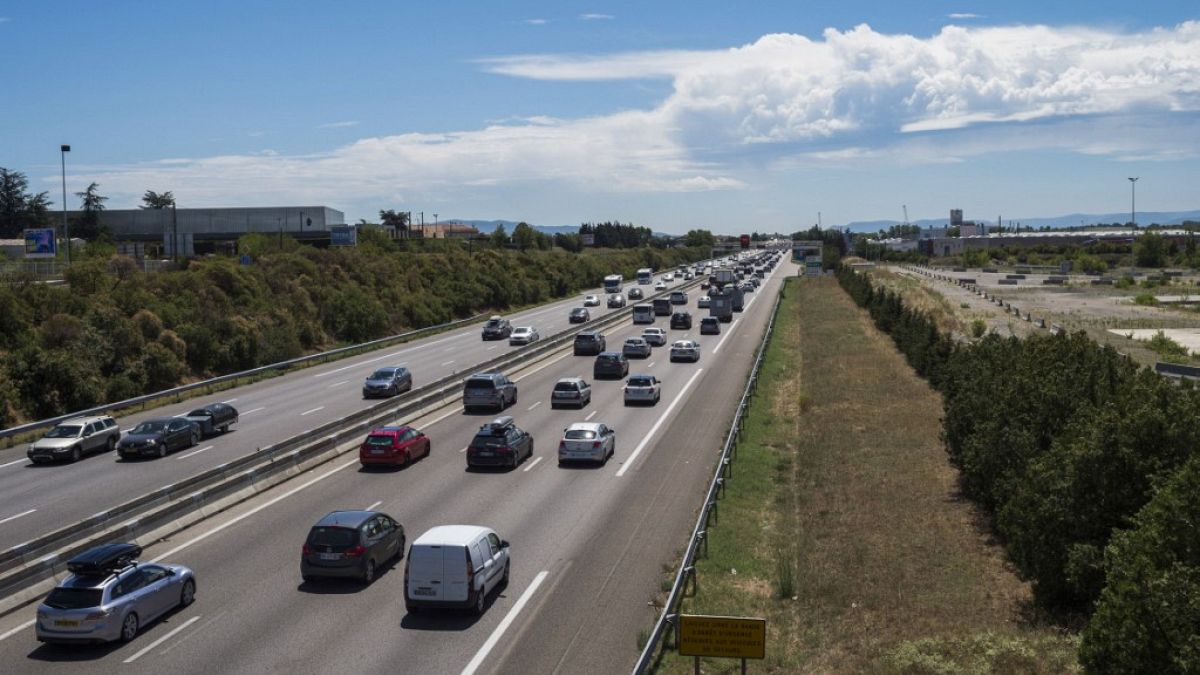Taxation of vehicles largely varies across Europe with environmental considerations playing a key role in some countries. Based on OECD data, Euronews Business looks at car prices before and after taxes in four different categories.
Taxes associated with the purchase, registration and use of vehicles have been a significant source of revenue for governments. Taxation is increasingly used to influence consumer behaviour for energy and environmental considerations, in particular, the transition to net-zero greenhouse gas emissions in recent years.
The level and structure of taxes, which may include value added tax (VAT), sales tax, excise duties and other fees and charges, when buying a new car can vary considerably across Europe.
So, how does VAT on passenger cars compare across Europe? How much tax do Europeans pay when buying cars? How do car prices before and after taxes vary across the continent? Euronews Business takes a look.
In 2022, VAT rates on car purchases varied among EU members from 17% in Luxembourg to 27% in Hungary according to the European Automobile Manufacturers Association (ACEA).
In most UE countries, people pay either 20% or 21% VAT when buying new cars. There are only six countries where the VAT rate is above 23%.
The VAT rate is not the main reason why car prices significantly vary before and after tax across Europe. Other taxes, fees and bonuses largely cause this. Instead of just comparing the VAT rates, it is more helpful to look at the price before tax and the final price, which includes all taxes and fees.
Based on the Organisation for Economic Co-operation and Development’s (OECD) Consumption Tax Trends 2022 report, we can look at the prices of some typical cars, with electric, hybrid and combustion engines in four categories.
The specifications of Category A are: SUV/Hatchback electric engine, power 150 KW (204 hp), battery capacity 58 kWh, consumption 17 kWh/100km, weight 1730 kg, CO2 emissions 0 g/km, battery range over 400 km (example Volkswagen ID3 performance).
In 2022, the price of a Category A car was $33,000 (€31,339) before tax in the simulation When the taxes were included, the price ranged from €26,938 in France to €59,168 in Turkey.
Final price less than the price before tax in France and Germany
The final price was less than the price before tax in France (€26,938), Luxembourg (€27,732), and Germany (€31,295), showing the level of bonuses in these three countries. In France, people paid €4,400 less than the price before tax when they bought a Category A car thanks to the ‘green bonus’.
At the top, Turkey was followed by Hungary (€39,801), Poland and Denmark (both €39,174).
People in Norway did not pay any taxes or fees according to the OECD report. People in the other two Nordic countries, Sweden and Iceland, paid less than €100 tax.
Taxes were less than €3,000 in Lithuania, Greece, Slovenia, and Switzerland when buying a Category A car, with a price of €33,339 before tax.
Taxes for a car with higher power and battery capacity
The power and battery capacity are higher in Category B cars in the simulation. The specifications are: Sedan electric engine, power 370 kW (496 hp), battery capacity 82 kWh, consumption 15 kWh/100km, weight 1830 kg, CO2 emissions 0 g/km, battery range over 400 km (example Tesla Model 3 Long Range Dual Motor).
When the price was €52,232 ($55,000) before tax in Category B, the final price varied from €52,009 in France to €98,163 in Turkey. A person in Turkey had to pay €46,831 tax to buy this car.
In France and Luxembourg, the final price was less than the price before tax, as both governments encouraged zero-emission vehicles (ZEVs).
Like in Category A, Norway did not charge any tax for Category B cars, and people in Iceland paid less than €1,000 tax in the simulation.
Apart from Turkey, people in Hungary, Ireland, Poland, and Denmark paid over €13,000 tax for a Category B car.
Taxes on hybrid cars
The specifications of Category C are: Sedan hybrid electric/fuel engines, fuel engine with cylinder capacity 1.8 litre, power 121 kW (162 hp), unleaded gasoline 95–98 RON, consumption 4.5 l/100 (combined) and electric engine with power 53 kW (71 hp), battery capacity 1.3 kWh, weight 1 800 kg, CO2 emissions 115 g/km, battery range less than 10 km, NOx emissions of 3 mg/km (example Toyota Corolla Hybrid LE).
The price before tax was €21,842 ($23,000) in the simulation. In this case, the final price including all taxes ranged from €21,494 in Germany to €46,393 in Turkey.
While the highest price was in Turkey, it was not an outlier in this modelling. Turkey was closely followed by Denmark (€45,633) and Norway (€45,062). In these three countries, the amount of tax was more than the price before tax. That means the final price was more than double the price before tax, indicating the level of taxation.
People in France, Iceland and Luxembourg paid less tax compared to other European countries in this category as well.
Taxes significantly rise for combustion engines
Category D vehicles in the simulation just consisted of those with combustion engines. The specifications are: Pick-up 4×4 with fuel engine, unleaded gasoline 95-98 RON, cylinder capacity 3.5 litre V6, power 300 kW (400 hp), consumption 12.4 l/100, CO2 emissions 296 g/km, NOx emissions of 20 mg/km, weight 2,200 kg; price USD50,000 (example Ford F-150 Ecoboost V6).
When the price before tax was €47,483 ($50,000) in 2022, the final price varied from €53,289 in Switzerland to €179,297 in Turkey. There were no countries where people paid less than the price before tax for a Category D vehicle.
Taxes more than double the price before tax in 7 countries
Taxation was clearly the highest in vehicles with combustion engines. The amount of tax was more than double the price without tax in seven out of 27 European countries.
To buy a Category D vehicle with a price of €47,483 before tax, the final prices people had to pay in 2022 were: €179,297 in Turkey, €146,716 in Denmark, €122,820 in the Netherlands, €117,759 in Norway, €105,898 in Finland, €96,519 in Iceland and €95,599 in France.
Apart from Sweden, where the final price was €59,354, people in the Nordic countries were at the top of the list, paying the highest for vehicles with combustion engines.
Looking at the average annual tax revenue per motor vehicle in major EU markets, it largely differed in 2022. Spain (€1,148) collected the least tax per vehicle whereas Belgium (€2,892) collected the most.
This figure was €1,625 in France, €1,764 in Germany, and €2,723 in Finland.
Germany collected €34.2 billion revenue from the VAT on vehicle sales, servicing, repair and parts, and sales and registration taxes. This figure was slightly above €20 billion in France (€21.7 billion) and Italy (€20.8 billion) in 2022.
Denmark, Sweden and Finland collected over €2 billion in this category while Greece (€1.2 billion) and Ireland (€1.5 billion) recorded the least.
Total tax from vehicles almost €400 billion in 13 EU countries
Motor vehicles are responsible for €374.6 billion in tax revenue for thirteen EU countries in the chart above.
In addition to sales and registration taxes, this figure included annual ownership taxes and more importantly, taxes from fuel and lubricants.
Turkey an outlier by far, relying on special consumption tax
The OECD data shows that Turkey was an outlier in the taxation of vehicles in all categories by far in 2022. The highest prices were recorded in Turkey in all four simulations. People first had to pay a very high rate of a Special Consumption Tax (ÖTV), which was between 60% and 220%. Then, they had to pay VAT (18%) on this.
In 2023, the minimum ÖTV rose to 80%, and the VAT to 20%. So, the final prices would be higher if the simulation was based on 2023 regulations.
By July of 2023, ÖTV revenues from vehicles accounted for 10% of all taxes that the government collected. This did not include VAT and other fees, showing how much the government has been relying on special taxes.
Cheapest places to buy electric cars
The final prices were lowest in France and Luxembourg in both electric vehicle types. The final prices were below the price before tax in both countries thanks to bonuses. People in France and Luxembourg did not pay any taxes in practice, but they enjoyed paying less than the price before tax.
People in Germany, Norway, Iceland, and Sweden were also lucky compared to other countries by paying less taxes and fees on electric vehicles.
When it comes to the taxation of vehicles with combustion engines, the policies of France and Norway have changed. Both countries were ranked in the top 7 in this category. Norway also ranked third in hybrid vehicles.
OECD: Taxation can help for green transition
Globally, transport was responsible for 25% of direct CO2 emissions from fuel combustion in 2018, mainly road transport according to ITF Transport Outlook.
“Well designed taxes can reduce pollution and greenhouse gas emissions very effectively,” OECD’s Consumption Tax Trends report suggested.
Meanwhile, in 17 of the OECD members in Europe, the CO2 emissions are directly taken into account to determine the level of taxation. They included Austria, Belgium, Czech Republic, Denmark, Finland, France, Greece, Iceland, Ireland, Italy, Lithuania, Netherlands, Norway, Portugal, Slovenia, Spain, and Sweden.
In 2022, some European countries such as France, Germany, Italy, and Sweden provided a “bonus” to the buyers of selected vehicles with low or no CO2 emissions. This might be a subsidy paid by the government or a local authority on the purchase of the vehicle.
A “malus”, which is an additional tax, charge or fee was imposed on vehicles with high CO2 emissions in some countries including Belgium, France, Italy, and Sweden.



